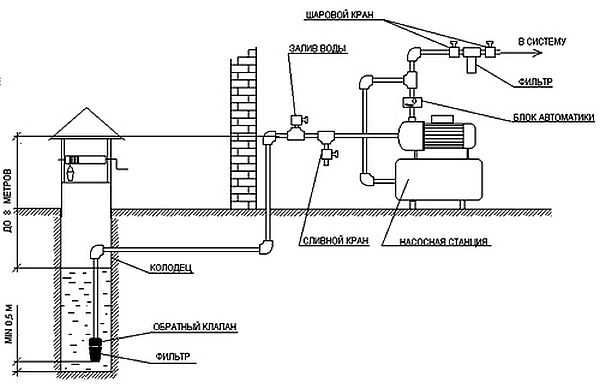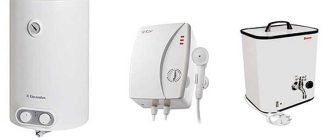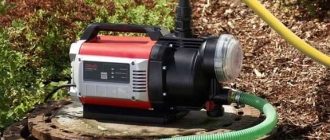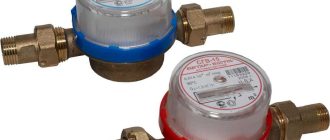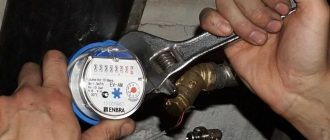Water supply of a private house is most often made from a well or borehole. Pumps are used for automatic supply. The type and capacity of the pump is chosen depending on the water flow rate and the height to which it needs to be raised. There are two types of private water supply systems:
- with a storage tank;
- with a hydroaccumulator.
For uninterrupted water supply of a private house with stable pressure and water supply can be put and storage tank and hydroaccumulator. This is an option for those who value comfort.
Contents of the article
System with a storage tank
The basis of such a system is a water tank, installed at a considerable height. If there is space, the tank is placed in the attic, when there is no such possibility, you can build a special tower or install the tank on the roof of a neighboring structure. From the tank on the house are pipes that divide the water to the points of consumption.
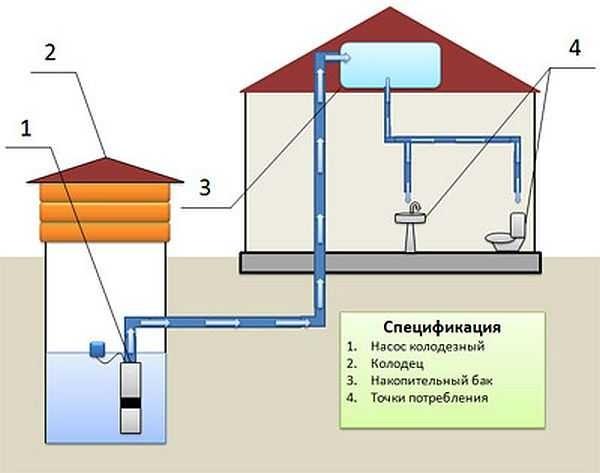
Water supply system of a private house with a storage tank (from a well or a borehole, it does not matter).
This system works like this:
- Water from a natural source is pumped into the tank by a pump, and its level is controlled by a float mechanism. When the threshold value is reached, the pump is switched off.
- Since the storage tank is located above all water distribution points, some pressure is created in the system. When the faucet is opened, this pressure causes water to flow into the distribution point.
- When the water level in the tank drops below a certain level, the pump is switched on, adding water.
The water supply system of a private house or dacha with a storage tank is simple and inexpensive. But there are many serious disadvantages:
- With this organization of water supply, the pressure in the system is low, and even variable – it depends on the level of water in the tank and the number of open taps. Because of this, no household appliances will not work (automatic washing machine, electric water heater (boiler), dishwasher, autonomous heating system, etc.).
- If the automation fails, there is a real danger of flooding the house with water overflowing over the edge. The danger can be reduced if you make a system of emergency water drainage. For this purpose, a pipe is welded into the storage tank just above the required water level, through which the excess water flows out in case of an increase in the level. The pipe can be led out into the sewer or drainage system, or – in the garden. But you need some indication that there is too much water in the tank (the sound of pouring water is also one of the signals).
- The tank has a solid size, and the place for it is not always easy to find. As an option – to build a tower near the house, on which to place the water tank.
If at the dacha no technique is not foreseen, you can use and such a scheme of water supply. But in the house, few people will be satisfied with this option. It is better to consider the following option.
Scheme with a hydroaccumulator and a pumping station
This system of water supply to a private house provides stable pressure, so you can connect any equipment. At the heart of the system is also a pump, it supplies water to the hydroaccumulator, and is controlled by an automation system. When all these components are combined into one device – it is called a pumping station.
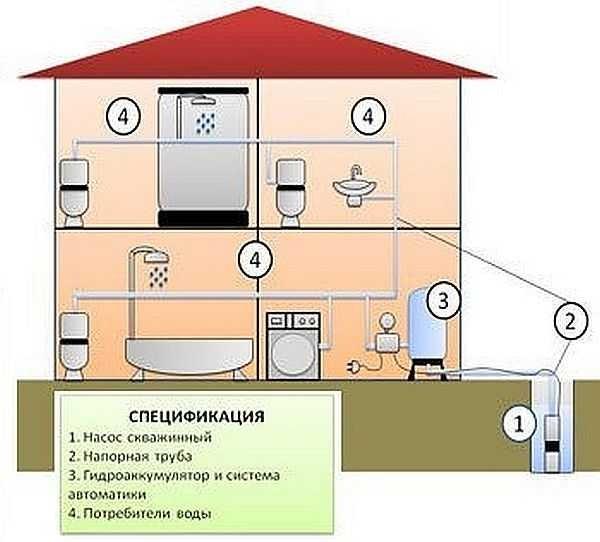
Hydroaccumulator for water supply – an iron tank, divided by an elastic membrane (rubber) into two parts. In one part gas is pumped under a certain pressure, in the second part water enters. Filling the tank, the water stretches the membrane, compressing the gas even more, which creates pressure in the system.
The principle of operation of the water supply system with a hydroaccumulator is as follows:
- The pump is turned on, pumps water, creating a preset pressure in the system. It is controlled by sensors. There are two of them: upper and lower pressure threshold. When the upper threshold is reached, the sensor switches the pump off.
- When the faucet is opened or water is consumed by the technician, the pressure in the system is gradually reduced. When the lower threshold is reached, a second sensor gives the command to turn on the pump. Water is supplied again, equalizing it.
Such a system of autonomous water supply is more comfortable. But for its organization requires more funds: a pumping station and a hydroaccumulator are quite expensive devices. In addition, this equipment is more demanding on water quality (a minimum of impurities) for which there should be a good filter. There are requirements and to the pipeline, and to the performance of the pump: water must be supplied constantly, without interruptions. When using a well as a source of water, it must have a good debit (water must come quickly), which is not always possible. Therefore, such schemes are more often realized with wells.
Water supply of a private house from a well and a well: laying pipes
Any of the described schemes of water supply of a private house is realized with the help of a pump that supplies water to the house. At the same time, a pipeline must be constructed, connecting the well or borehole with a pumping station or storage tank. There are two options for laying pipes – for summer use only or for all-season (winter) use.
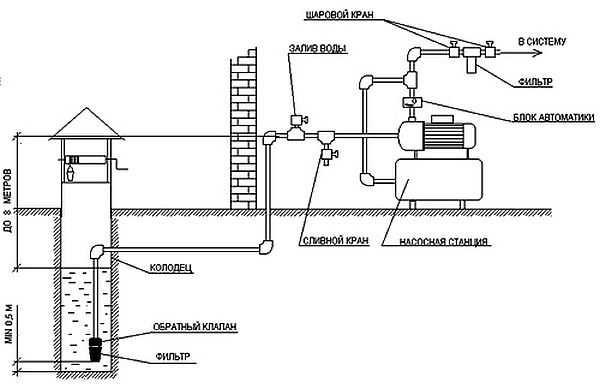
When arranging a summer water supply system for a summer cottage, pipes can be laid on top or in shallow ditches. In this case, do not forget to make a tap at the lowest point – to drain the water before winter, so that in the frost frozen water did not break the system. Or make the system collapsible – from pipes that can be rolled on threaded fittings, and these are HDPE pipes. Then in the fall everything can be disassembled, twisted and put in storage. In the spring, everything is returned.
Laying water supply pipes on the site for winter use requires a lot of time, effort and money. Even in the most severe frosts, they should not freeze. And there are two solutions:
- lay them below the depth of ground freezing;
- bury them shallowly, but be sure to heat or insulate them, or they can be combined.
Deep burying
Deeply bury water pipes makes sense if it freezes to no more than 1.8 m. Digging will have to be 20 cm deeper, and then pour sand at the bottom, in which to lay the pipes in a protective shell: they will be subjected to load, because there is almost a two-meter layer of soil on top. Asbestos pipes used to be used as a protective casing. Today there is also a plastic corrugated sleeve. It is cheaper and lighter, it is easier to lay pipes in it and give the desired shape.
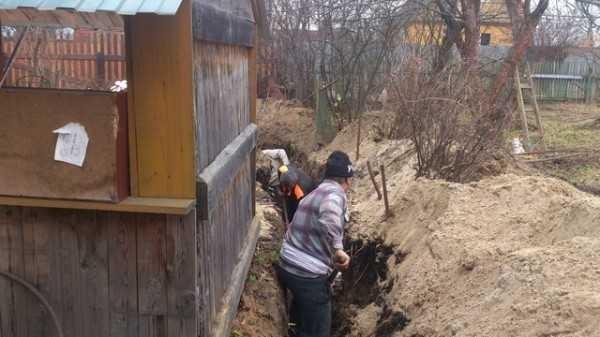
Although this method requires a lot of labor, but it is reliable. In any case, the section of the water pipeline between the well or borehole and the house try to lay it below the depth of frost. The pipe is led through the wall of the well below the depth of ground freezing and in a trench lead under the house, there raised above. The most problematic place – the exit from the ground into the house, can be additionally heated with an electric heating cable. It works in automatic mode, maintaining the set heating temperature – it works only if the temperature is below the set temperature.
When using a well as a water source, it is better to install the pumping station in a caisson. The caisson is buried below the depth of ground freezing, and the equipment is placed in it. The casing pipe is cut so that it is above the bottom of the caisson, and the pipeline is led through the wall below the freezing depth.
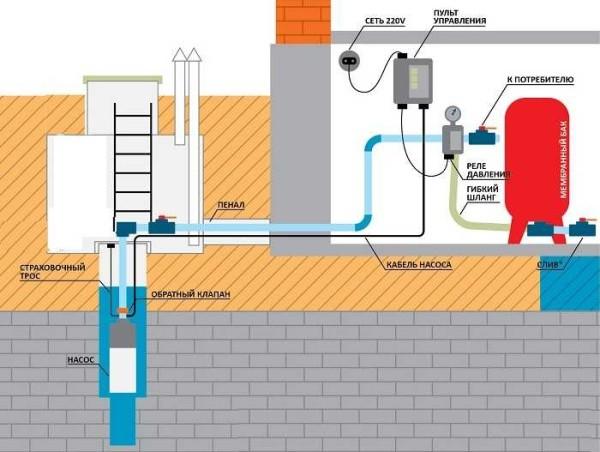
Buried in the ground, the water pipe is difficult to repair: it will have to be dug. Therefore, try to lay a solid pipe without joints and welds: it is they give the most problems.
Close to the surface
In case of shallow laying there is less earthwork, but in this case it makes sense to make a full-fledged route: the trench is lined with bricks, thin concrete slabs, etc. At the construction stage, the costs are significant, but the operation is convenient, repair and modernization – without problems.
In this case, the water supply pipes of a private house from the well and well are raised to the level of the trench and there are removed. They are laid in thermal insulation, preventing them from freezing. For insurance, they can also be heated – use heating cables.
One practical advice: the power supply cable from the submersible or well pump to the house it is better to hide it in a protective sheath of PVC or other material. It is better to attach the cable to the pipe every meter with tape. Thus, you will be sure that the electrical part is safe, the cable will not fray and will not break: in case of ground movement the load will be on the pipe.
Sealing the entrance to the well
When organizing the water supply of a private house from the well with your own hands, pay attention to sealing the place of exit of the water pipe from the shaft. It is from here that most often dirty water comes inside.
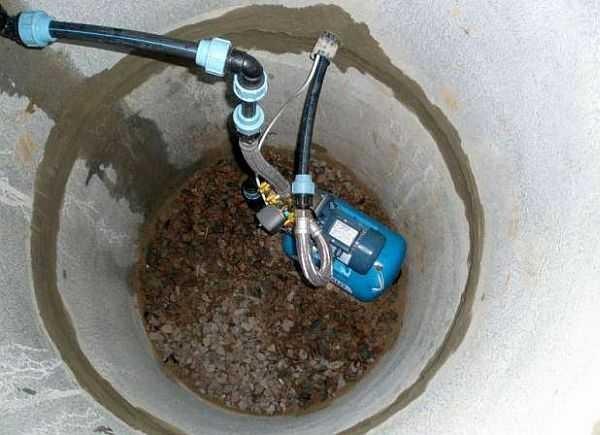
If the hole in the shaft wall is slightly larger than the diameter of the pipe, the gap can be sealed with sealant. If the gap is large, it is filled with mortar, and after drying, it is smeared with a waterproofing compound, bitumen impregnation, for example, or a cement-based compound. It is desirable to lubricate both outside and inside.
What it consists of
The source of water and the entry of the route into the house – not the entire water supply system. Filters are also needed. The first, coarse filtration takes place at the suction point. In this form, it can be used for technical purposes, for example, lead into the toilet. But even for irrigation, untreated water can not be supplied in every case, and in the shower or kitchen – even more so. Therefore, the water supply of a private house from a well and well includes a system of filters.
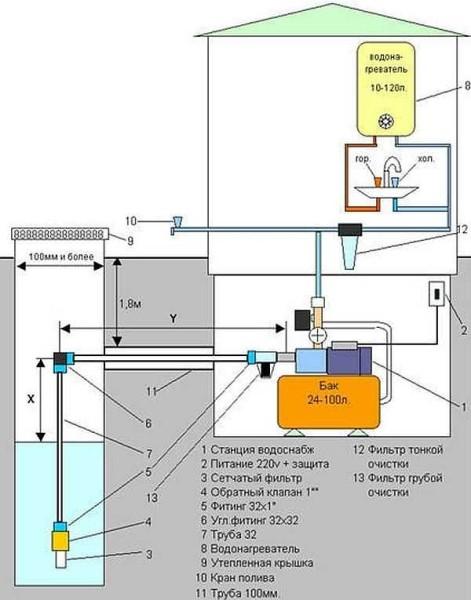
Note, in the figure there are three stages of filtration:
- on the suction pipe – mesh filter;
- before entering the pump – coarse filter;
- before the supply to the house – fine filter.
At each of the stages, the filter (or filters) is selected depending on the water. Its quality is determined in a laboratory. Based on the chemical composition and selects equipment for purification.
Autonomous water supply
All are good systems with pumping stations, except for the fact that their work requires electricity. There is a reserve of water, but it is equal to the volume of the hydroaccumulator, and it is not more than 100 liters. Such a quantity will not be enough for a long time. If you need a reserve stock for at least a day or more, it is best to pump water first into the storage tank, and from it to supply the input of the pumping station. The same system works well in case your house is connected to the centralized water supply, but in it the pressure is very low or water is supplied by the hour.
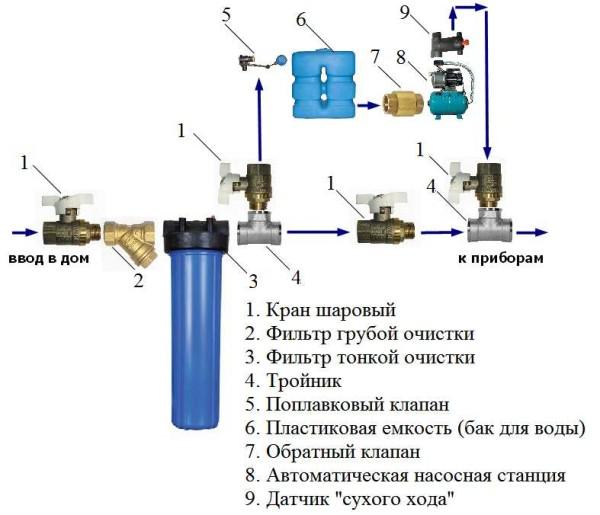
In the scheme presented in the photo, there is only no emergency overflow. This is a pipeline coming out of the storage tank just above the maximum water level. It is led out into the sewer system. Through it, excess water flows down in case of malfunctions with the float mechanism. If it is not installed, you can flood your home.
If you need a backup water supply of a private house in case of power failure, the accumulator should be installed on top, above all points of water intake. Then, in case of power outage, water will flow into the pipes by gravity. You will not be able to take a shower, but it will be in the taps. This will be an uninterrupted water supply of a private house in any conditions.

